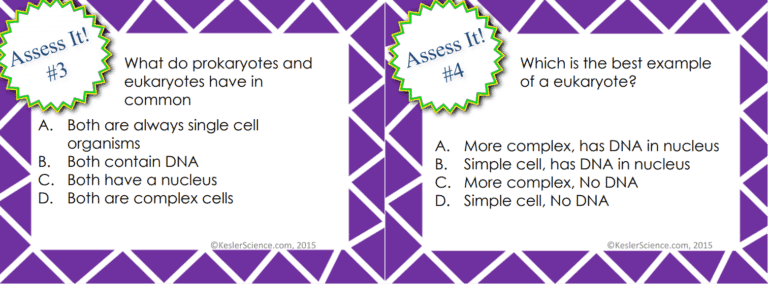Prokaryotic and Eukaryotic Cells Lesson Plan - A Complete Science Lesson Using the 5E Method of Instruction
At the end of this prokaryotic and eukaryotic cells lesson plan, students will be able to identify the basic characteristics and mode of reproduction of prokaryotic and eukaryotic cells that classify them in the currently recognized Kingdoms. Each lesson is designed using the 5E method of instruction to ensure maximum comprehension by the students.
The following post will walk you through each of the steps and activities from the prokaryotic and eukaryotic cells lesson plan.
ENGAGEMENT
Objective Introduction
At the beginning of the lesson, the class will do a Think-Pair-Share to discuss the objective.
Class Activity
- Tell students that today they will be learning about the two basic types of cells, prokaryotic and eukaryotic. They will be looking at characteristics of these cells.
- The slideshow will give them an idea of how small cells are in comparison to other known items.
- You can easily go back and forth through the slideshow to help students determine sizes.
Student Activity
- Ask students to make a list of the items they see in the slideshow.
- Have them estimate the size of each item.
- Now explain that the last four items are prokaryotes and those above are eukaryotes.
- Ask students to think about how scientists study such small things.
- What cell characteristics might make the eukaryotes larger than prokaryotes?
- What cell characteristics might make prokaryotes smaller than the eukaryotes?
- This is just one characteristic of prokaryotes and eukaryotes. Ask the students to brainstorm other characteristics that cells might have.

The teacher will help to clear any misconceptions about prokaryotic and eukaryotic cells. Some may have no concept of how small cells are, larger organisms do not generally have larger cells than smaller organisms; but instead, they have more cells.
Estimated Class Time for the Engagement: 20-30 minutes
EXPLORATION
This student-centered station lab is set up so students can begin to explore prokaryotic and eukaryotic cells. Four of the stations are considered input stations where students are learning new information about prokaryotic and eukaryotic cells and four of the stations are output stations where students will be demonstrating their mastery of the input stations. Each of the stations is differentiated to challenge students using a different learning style. You can read more about how I set up the station labs here.
EXPLORE IT!
Students will be working in pairs to better understand prokaryotic and eukaryotic cells. Students will be comparing two diagrams of prokaryotic and eukaryotic cells and will try to identify the differences and similarities. Students will follow the steps and record their observations on their lab sheet.
WATCH IT!
At this station, students will be watching a short video explaining prokaryotic and eukaryotic cells. Students will then answer questions related to the video and record their answers on their lab station sheet. For example: According to the video, which types of cells came first? What does the prefix prokary mean? List 2 characteristics that a eukaryotic cell has that a prokaryotic cell does not have.
RESEARCH IT!
The research station will allow students to explore a web page that allows students to research information about prokaryotic and eukaryotic cells. Students will be instructed to complete a few tasks and record answers on their lab sheets.
READ IT!
This station will provide students with a one page reading about prokaryotic and eukaryotic cells. In the reading, students will understand how they are both similar and different. There are 4 follow-up questions that the students will answer to show reading comprehension of the subject.
ASSESS IT!
The assess it station is where students will go to prove mastery over the concepts they learned in the lab. The questions are set up in a standardized format with multiple choice answers. Some questions include: Which organism is made up of one prokaryotic cell? Which is true about the nucleus in a prokaryotic cell? What do prokaryotes and eukaryotes have in common? Which is the best example of a eukaryote?

WRITE IT!
Students who can answer open-ended questions about the lab truly understand the concepts that are being taught. At this station, the students will be answering three task cards: How are prokaryotic and eukaryotic cells similar? Describe the nucleus in a eukaryotic cell. Provide an example organism that is prokaryotic and one that is eukaryotic.
ILLUSTRATE IT!
Your visual students will love this station. Students will draw a quick sketch of a prokaryotic cell and a eukaryotic cell. The students will also sketch and label the DNA in each of their cells.

ORGANIZE IT!
The organize it station allows your students to look at a number of descriptions. Students will have to identify whether those descriptions are for prokaryotic cells, eukaryotic cells, or for both. Once students have completed their organization, the teacher will come and check their understanding.
Estimated Class Time for the Exploration: 1-2, 45 minute class periods
EXPLANATION
The explanation activities will become much more engaging for the class once they have completed the exploration station lab. During the explanation piece, the teacher will be clearing up any misconceptions about prokaryotic and eukaryotic cells with an interactive PowerPoint, anchor charts, and notes. The prokaryotic and eukaryotic cells lesson includes a PowerPoint with activities scattered throughout to keep the students engaged.

The students will also be interacting with their journals while taking notes from the PowerPoint. If you have students that need modified notes, the 5E lessons come equipped to help give every student access to the lesson.
Estimated Class Time for the Exploration: 2-3, 45 minute class periods
ELABORATION
The elaboration section of the 5E method of instruction is intended to give students choice on how they can prove mastery of the concept. When students are given choice the ‘buy-in’ is much greater than when the teacher tells them the project they will have to create. The elaboration project will allow students to create a number of different project ideas ranging from creating a scale drawing of the two types of cells to designing a model.
Estimated Class Time for the Elaboration: 2-3, 45 minute class periods (can also be used as an at-home project)
EVALUATION
The final piece of the 5E model is to evaluate student comprehension. Included in every 5E lesson is a homework assignment, assessment, and modified assessment. Research has shown that homework needs to be meaningful and applicable to real-world activities in order to be effective. When possible, I like to give open-ended assessments to truly gauge the student’s comprehension.
Estimated Class Time for the Elaboration: 1, 45 minute class period
DOWNLOAD THE FULL LESSON NOW
The full lesson is available for download from the Kesler Science Store. Save yourself a ton of time and grab it now.
Download Over $100 in FREE Resources
For Middle School Science
Simply create a login below and gain immediate access to a selection of our Kesler Science product line worth $100 - for FREE. There's a full version of every product type! You'll also join tens of thousands of middle school science teachers who receive timely tips and strategies straight to their inbox.





